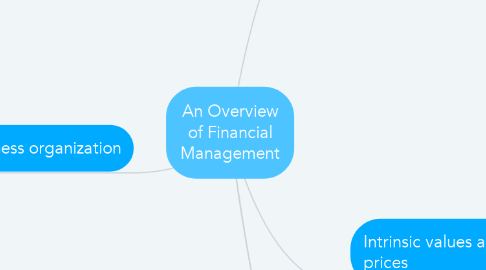
1. Forms of business organization
1.1. Proprietorship:
1.1.1. One individual
1.1.2. Advantages
1.1.2.1. Easily and inexpensively formed
1.1.2.2. Subject to few government regulations
1.1.2.3. Subject to lower income taxes
1.1.3. Disadvantages
1.1.3.1. Unlimited personal liability
1.1.3.2. Limited to life of individual
1.1.3.3. Difficulty obtaining large sums of capital
1.2. Partnership
1.2.1. 2 or more persons
1.2.2. Advantages
1.2.2.1. More capital available
1.2.2.2. Income taxed once as personal income
1.2.2.3. Diversity of managerial expertise
1.2.2.4. Easily and inexpensively formed
1.2.3. Disadvantages
1.2.3.1. Unlimited liability of the owner for debts
1.2.3.2. Potential for conflict between partners
1.2.3.3. Partnership dissolves when 1 partner dies or wishes to sell
1.2.3.4. Difficult to transfer ownership
1.3. Corporation
1.3.1. Advantages
1.3.1.1. Limited liability, unlimited life
1.3.1.2. Separation of ownership and management
1.3.1.3. Transfer of ownership is easy
1.3.2. Disadvantages
1.3.2.1. Double taxation
1.3.2.2. Cost of set-up and report filing
1.3.3. S Corporation (<75 stockholders)
1.4. Limited Liability
2. What is Finance?
2.1. Finance versus Economics and Accounting
2.1.1. Economics: asset's value is based on future cash flows
2.1.2. Accounting: provided information those cash flow
2.2. Corporate finance, Capital markets, Investments
2.2.1. Corporate Finance (Financial management)
2.2.1.1. Financing decision
2.2.1.2. Investment decision
2.2.1.3. Dividend decision
2.2.2. Capital markets
2.2.2.1. Determine
2.2.2.1.1. Interest rates
2.2.2.1.2. Stock and bond prices
2.2.3. Investment
2.2.3.1. Security ananlysis
2.2.3.2. Portfolio theory
2.2.3.3. Market analysis
3. Intrinsic values and Stock prices
3.1. Intrinsic value
3.2. Market price
3.3. Marginal investor
3.4. Equilibrium
3.5. Market Price < Intrinsic Value => Stock Undervalued => Should buy
3.6. Market Price > Intrinsic Value => Stock Overvalued => Shouldn't buy
4. Stock prices and shareholder value
4.1. Shareholder Wealth Maximization
4.1.1. Maximize long-run value of firm's common stock
